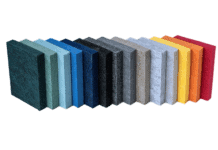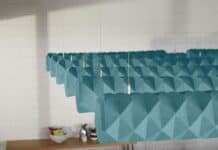By Joerg Hutmacher
Published in the May 2011 issue of Today’s Facility Manager

Facility managers (fms) who haven’t looked up in a while may be missing the big picture, since options abound for ceiling applications today. The old utilitarian drop ceiling with standard issue fiberglass tiles is no longer the only commonly found choice. Ceiling options have gained ground with buzzwords like: organic, recycled, sustainable, LEED, concealed edges, clouds, and contours being used more and more. New offerings not only energize aesthetics but also improve acoustics and help further environmental goals.
Twenty first century ceiling choices transcend the grid or box. In today’s facilities, mechanical systems can be left exposed for a contemporary look with ceiling tiles that directly and securely mount to the surface without the need for a suspension system. And ceilings can take on added dimensions with the use of clouds and baffles.
Whether the intended look is whimsical, warehouse, or “wow,” a ceiling application does not have to be predictable. It should, however, be practical. For the most part, the fun part of planning and designing or remodeling a space is selecting the components. Do looks matter? Most definitely. But form follows function, and the ceiling can be an effective way to add acoustical control without compromising aesthetics of the space.
Most any interior space benefits from acoustical control products to improve communication and ensure the comfort and well-being of occupants. For example, a medical clinic with open space above a drop ceiling may allow sound to carry, inhibiting private conversation between providers and patients. A classroom or other education environment that lacks materials to prevent sound reverberation can affect students’ ability to hear and hinder their learning.
Meanwhile, a manufacturing facility with excessive noise levels can cause stress and fatigue, contributing to workplace injuries and hearing loss. And an open office space where sound travels over partitions and reverberates around the room makes it challenging to converse with co-workers or customers and creates a productivity black hole.
Material Matters
Optimizing the sound environment helps to maximize the potential of both the space and the people who use it. The privacy of a clinic, the concentration of students in a learning space, the safety and productivity of a manufacturing facility, the comfort and efficiency of office staff are all impacted by ceiling choices.
Items such as ceiling tiles, clouds, and baffles help to facilitate the intended function of spaces by reducing overall noise, controlling reverberation, and dissipating sound waves. Some ceiling solutions also reduce sound transmission to adjacent rooms that may occur through the open space in the plenum above a drop ceiling.
How do fms who are conscious of, and concerned about, sound and its ramifications make the right choice? Determining needs related to both function and form and being aware of all of the options is a good starting point.
Mineral fiber or fiberglass: This type of material provides some sound absorption, reducing echo or sound reverberation (see sidebar for glossary of terms).
Acoustical Ceiling TermsEcho: Reflected sound producing a distinct repetition of the original sound. Can also be described as the perception of two distinct sounds resulting from the difference in arrival times of sound waves traveling over different paths but originating from a single source. Noise Reduction Coefficient (NRC): A single number rating system for absorption coefficients over the speech frequency range. The NRC of an acoustical material is the mathematical average to the absorption coefficients at 250, 500, 1,000, and 2,000 Hertz (Hz). Reverberation: Sound, after it is ended at the source, will continue to reflect off surfaces until the sound wave loses energy by absorption, to die out eventually. It is the amplification of sound within an enclosed space caused by multiple reflection off surfaces (walls, ceilings, floors) of the room. Sound Absorption: Property possessed by materials, objects, and air to convert sound energy into heat. Sound waves reflected by a surface cause a loss of energy. The energy not reflected is called an absorption coefficient. |
- Calls for ceiling grid application
- Features a traditional appearance
- Conceals mechanical systems
- Can provide good light reflectancy and thermal value
- Are available in many patterns and styles
- Each product has a different finish and/or texture and may require a specific method of cleaning. Fms should consult the manufacturer for cleaning instructions.
- Commonly found in schools, government facilities, and office buildings
Wood: Certain styles, including perforated tiles with acoustical backer, provide some sound absorption.
- Calls for ceiling grid application or clouds suspended from ceiling with cables
- Lends a warm, earthy, sophisticated appearance
- Can have high recycled content or be Forest Stewardship Council (FSC) certified
- Can qualify for LEED credits
- Impact resistant
- Durable, rigid, and stable
- Flame retardant
- Available in many styles and colors
- Easy to maintain by wiping clean with damp cloth
- Commonly found in libraries, showrooms, conference/training rooms, museums, and entertainment facilities

Metal: This type of ceiling option provides sound absorption with optional acoustical backer or material.
- Calls for ceiling grid application or clouds suspended from ceiling with cables
- Features a contemporary, sleek look
- Tiles with appropriate open rate can be suspended under sprinkler heads.
- May have high recycled content
- Available in chrome, white, black, and other colors
- Can qualify for LEED credits
- Flame retardant
- Requires little to no maintenance
- Commonly found in museums, stadiums, convention centers, offices, malls, and retail stores
Acoustical Foam: These items provide excellent sound absorption and improve speech intelligibility.
- Certain products can minimize sound transmission to adjacent rooms.
- Offered in a variety of product types for ceiling grid application, direct installation on surface with adhesive mechanical fasteners, or clouds or baffles suspended from ceiling with cables
- Flame retardant
- Mold resistant
- Provides good light reflectancy (in white)
- Available in custom and standard colors and patterns
- Can qualify for LEED credits
- Lightweight and easy to install
- HPC coated; vacuum as needed and wipe clean with damp cloth
- Commonly found in schools, lobbies, offices, entertainment facilities, health care facilities, lodging facilities, conference and boardrooms, manufacturing facilities, and retail stores
Sustainable Materials: There are a variety of options (e.g., sintered glass, jute) that can provide exceptional acoustical properties to reduce noise and echo.
- Calls for ceiling grid application
- Certain products can be directly installed on surface with adhesive.
- Distinctive appearance; can blend with environment or other building materials
- May have high recycled content or be made from sustainable materials
- Can qualify for LEED credits
- Flame retardant
- Product materials differ and may require a specific method of cleaning. Fms should consult the manufacturer for cleaning instructions.
- Often used in cafeterias, hallways, staircases, corridors, religious and community centers, and public buildings
Fabric/Vinyl Wrapped: These items provide sound absorption to reduce reverberation or echo.
- Calls for ceiling grid application
- Flame retardant
- Fabric provides custom, soft look
- Easy to clean and durable
- To account for the various materials used in making these products, fms should consult the manufacturer for cleaning instructions.
- Vinyl products can meet USDA and FDA requirements for food processing and clean rooms.
- Often used in schools, community centers, and public buildings
Blend Form And Function
Today, fms have more ceiling options than ever before in terms of aesthetics, materials, suspension and mounting options, and physical properties (such as acoustical performance, impact and mold resistance, and fire rating). To make the right choice for a space, fms should first determine the function and form requirements. When those specifications are synchronized with product attributes, selecting the right ceiling solution for an interior space will not only enhance the ambiance of the surroundings, but may also improve the potential of a space and the people who use it.
Hutmacher is business unit manager at pinta acoustic, inc., a Minneapolis, MN provider of decorative, acoustical, and noise control solutions for the educational, architectural, facilities, broadcast/audio, and industrial markets.



















![[VIDEO] Collect Asset Data at the Speed of Walking a Building](https://facilityexecutive.com/wp-content/uploads/2024/02/maxresdefault-324x160.jpg)